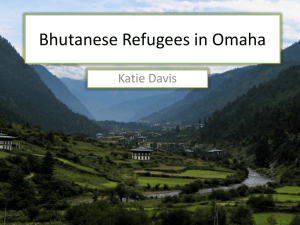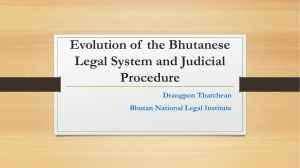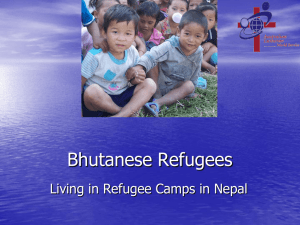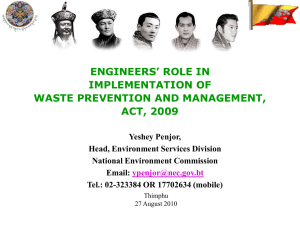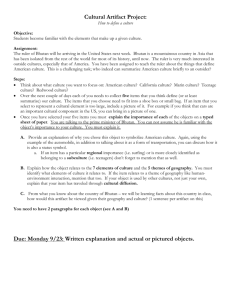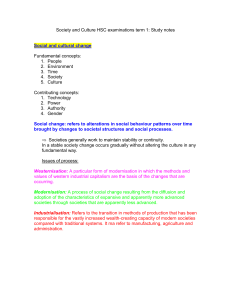here - EEPA
advertisement
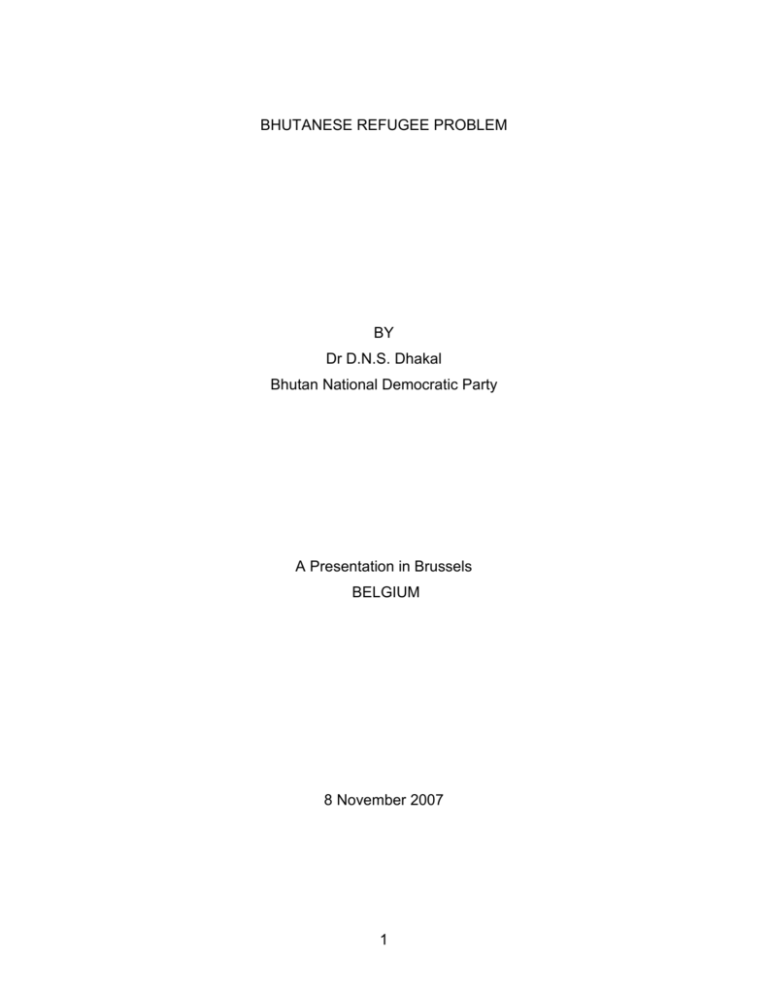
BHUTANESE REFUGEE PROBLEM BY Dr D.N.S. Dhakal Bhutan National Democratic Party A Presentation in Brussels BELGIUM 8 November 2007 1 INTRODUCTION For the last one and half decades the refugee community maintained to the outside world that their only choice was to return to Bhutan. This had kept the international community in a quandary – whether or not they would have a role in the resolution of the problem. All the Bhutanese dissident leaders as well as the common refugees in the camps had been pinning their hopes on an Indian decision to negotiate a solution with Bhutan. India, however, has not given any indication of change in its original position that “Nepal and Bhutan should solve the problem bilaterally”. Nepal, the United States, and the European Union have given up hope for India’s involvement. Thus, there has developed a longing among the refugee communities to seize any option that would enable them to come out from the trap of their existing stateless confinement. Inside Bhutan some political changes have taken place. In a significant move Crown Prince Jigme Khesar Namgayel Wangchuck became the fifth Druk Gyalpo (King of Bhutan) on 17 December 2006. Two political parties, formed by the former bureaucrats, royalists and members of the royal family, have registered with Bhutan’s election commission to contest the first democratic election scheduled for 2008. All the political parties formed in exile, which have been fighting for political reforms in Bhutan since 1990, are denied registration. It is not clear at the moment whether or not any of the refugees, including those recognized as Bhutanese citizens by the Joint Verification Team in Khudunabari refugee camp, would be allowed to return to Bhutan and participate in the election. A meeting held in Delhi on 31 March 2007 under the banner of Bhutan Solidarity, and attended by prominent human rights activists, leaders of social movements and members of all the major political parties of India, has declared the democratic exercise in Bhutan an “eye wash” to the international community. 2 After waiting more than fifteen years, and after having spent more than USD 200 million, the international community has decided to take the plunge for resolution of the Bhutanese refugee problem. A five-member core group of nations that was formed in September 2006 in New York under the leadership of the United States of America has made significant progress. The United States has received approval from the Government of Nepal to establish Overseas Processing Entity in the camps to process the application of some 60,000 refugees for resettlement in the US. Other countries, namely, Canada, Australia, New Zealand and some EU member states have shown interest in sharing the responsibility for resettlement of Bhutanese refugees. Ellen R. Sauerbrey, US Assistant Secretary of State for Population, Refugees and Migration, has made an announcement in Kathmandu on November 3 last week that the first batch of Bhutanese refugees would be landing in the US for resettlement by January 2008. Some 15000 Bhutanese refugees are expected to be re-settled annually in the USA. This offer has come as a surprise to Bhutan observers. Naturally, it has generated a mixed reaction among the Bhutanese refugee community and their supporters in India and Nepal. Some have welcomed the offer, some are indifferent, and some oppose it on the grounds that the perpetrators of largescale human rights abuses, that is, the regime in Thimphu, would escape with impunity what must be classed as a serious international crime. Legal experts have concluded that the Thimphu regime manipulated legal means to achieve ethnic cleansing. Indeed, one sixth of the population of Bhutan was forced into exile; its government continues to flout the thesis of “One People One Nation”; and there is no guarantee that the Lhotsampas remaining in Bhutan, who still constitute about 25% of the country’s population, will not be made refugees or at least suffer ill-treatment as second class citizens. 3 THE REFUGEE ISSUE Some 84,000 Bhutanese refugees arrived in Nepal for asylum in the early 1990s. They carried with them the pains of blatant violation of human rights perpetuated by the security forces of the Royal Government. The overwhelming majority of them are Bhutanese of Nepali ethnicity practicing the Hindu religion. Initially, these asylum seekers attempted to stay in India. Once their appeal for Indian protection was rejected, they were forced to travel hundreds of kilometers across Indian territory to the Kakarvitta frontier post in Nepal. It is understood that the Government of India was considering transporting the evictees thousands of kilometers away to the southern states in India had Nepal rejected their request for asylum. Whether it was immaturity, emotional attachment to ethnicity, or commitment to human rights and democracy, Nepal decided to grant asylum to the Bhutanese refugees. To support them, Nepal requested help from UNHCR and through it from the international community. The international community generously contributed towards their welfare. Today, there is sanitation, a school education system, a health program, and skill training and adult education in the camps. There is 100% school enrollment among the refugee children, and every refugee family probably has at least one graduate. So far Nepal has provided space and contributed towards maintenance of law and order and security in the camps. It continues to maintain that the refugee exodus is a tragedy, which requires cooperation from all stakeholders to find an amicable solution. Over the years the registered refugee population in the camps is reported to have increased to 107,000. The UNHCR and Nepal government have undertaken a systematic re-enumeration exercise to confirm the population of the registered Bhutanese refugees. 4 BILATERAL EFFORT Nepal and Bhutan began bilateral negotiations in April 1993 in an effort to find an amicable resolution of the refugee problem. To ensure Bhutan’s cooperation, Nepal agreed to classify the refugees into four groups: (I) Bhutanese who were forcibly evicted; (II) Bhutanese who emigrated voluntarily; (III), non-Bhutanese people; and (IV), Bhutanese with criminal records. Nepal quickly realized that the classification process would have far reaching consequences for the refugees. All the Bhutanese refugee organizations rejected the classification process that had been negotiated between the two governments without consultation and demanded that, if classification was indeed needed, it should simply differentiate between Bhutanese and non-Bhutanese. Nepal hoped that the evolving political events in Bhutan would overshadow the bilateral agreement. It believed that Bhutan would adopt a democratic polity during the process of the negotiation, and that would relegate any caveats in the agreement as non-issues. In such a situation, the eventual return of the refugees to their homeland with honor and dignity would be facilitated. Nobody in Nepal had anticipated that the process of political change in Bhutan would be complex and so long drawn out. Furthermore it was expected that India would play a positive role in convincing the Bhutan Government to take back the refugees. Events did not unfold that way. India has continued to maintain that the refugee problem should be solved bilaterally by Bhutan and Nepal. Repeated attempts to work under the bilateral framework did not yield any results. Eventually, the international community was compelled to intervene. The then UNHCR chief, Sadoka Ogata, visited Bhutan, Nepal, and India in April 2000. This was followed by the Bhutan Aid Consortium Round Table Meet in Thimphu, Bhutan, where the overwhelming majority of the participating countries and donor organizations expressed concern over the plight of the Bhutanese refugees in Nepal and emphasized the need for an amicable resolution of the 5 problem at the earliest possible moment. Later in the year the United States took the initiative and sent Julia Taft and Karl Inderfurth, Under Secretaries of State, to Thimphu in an attempt to convince the Royal Government to commission a Joint Verification Team (JVT) with Nepal and begin verification of the refugees in the camps. Bhutan agreed to the US proposal and came forward to join Nepal in the verification process in March 2001. The JVT completed the verification of some 12,500 refugees in Khudunabari camp in December 2001. It took almost two years for tabulation and harmonization of the position on each of the categories. Bhutan agreed to allow the refugees in category I to return as Bhutanese citizens, those in category II would have to wait anywhere from 2 to 20 years to become full Bhutanese citizens but could exercise an option to return. Those in category IV could exercise their option to return but would have to face the court of justice in Bhutan. Finally, Bhutan refused to take any responsibility for those falling in category III. The possible date to begin repatriation was scheduled for 16 February 2004 and the Government of India had agreed to provide safe passage through its territories for the returnees. The results of the verification of Khudunabari camp came as a surprise to the refugee communities. Of the total verified refugees, 2.5% were placed in category I, 70.6% in category II, 23.4% in category III, and 2.9% in category IV. When the JVT visited Khudunabari camp to announce the results and the terms and conditions for repatriation, there was a scuffle between the refugees and the Bhutanese officials. This was used as an excuse by the Bhutanese team to abruptly return to Bhutan in December 2003 without informing the Nepal Government. This left the negotiating process in limbo. A serious complicating factor in these long drawn out negotiations was that the Government of Bhutan had refused to allow third-party observers; even the UNHCR was excluded. Similarly, the international human rights watchdogs had 6 expressed concerns at the absence of any appeal mechanism for those refugees who were allocated to categories II, III and IV, nor was any representation from the refugee communities permitted to take part in the process. Even a year old child was placed in category IV, thus characterized as a criminal to be tried in the Bhutanese court of law. All stakeholders have come to realize that the bilateral effort will not yield any positive outcome. Now the international community has entered into negotiations expressing wiliness to share the responsibility of a large proportion of the refugee population. NEPAL’S APPROACH TO THE BHUTANESE REFUGEE PROBLEM Nepal is a third country of asylum for Bhutanese refugees. Its government engaged the office of the UNHCR for their upkeep and provided land for housing them. Six refugee camps are located in Jhapa District and one in Morang District. The Refugee Coordination Unit, under the Ministry of Home Affairs, Government of Nepal, coordinates with UNHCR to update information on asylum seekers, deals with issues related to travel documents, and helps maintain law and order in the camps. It operates a police post in each camp. The Chief District Officer represents the Government of Nepal in overall dealings with UNHCR in the camps. Quite early in the 1990s the Parliament of Nepal mandated that the government find an amicable resolution to the refugee problem resorting to (1) bilateral negotiations with Bhutan; if that failed, (2) to request assistance from the Government of India in convincing Bhutan to work for an amicable resolution; and if that also failed, (3) to internationalize the issue by seeking Western assistance. Thus far Nepal has maintained its support for repatriation of the Bhutanese refugees with honor and dignity as the real option. 7 Nepal has completed 15 rounds of negotiations with Bhutan and there is no indication that an amicable resolution will be found in the near future. Nepal agreed on categorization of the refugees, formed the Joint Verification Team with Bhutan, completed verification of some 12,500 individuals in Khudunabari camp, and agreed to place the verified refugees into four categories taking for granted that Bhutan was sincere in its efforts to resolve the problem. Thus far, not a single refugee, including the ones accepted by Bhutan as Bhutanese citizens, has been repatriated. On several occasions Nepal has sought assistance from India in convincing Bhutan to take back its citizens, respecting their rights to return to their homes in southern Bhutan. From the beginning, in 1993, Nepal had consulted India, and it is believed that the Nepalese delegation agreed to Bhutan’s proposal for categorization of the refugees into four groups after consulting with Indian establishments. Prime Minster Girija Prasad Koirala himself had raised this issue with the Indian government in 2001, and on every possible occasion Nepal has raised the issue of the refugees with Indian dignitaries both in Kathmandu and New Delhi. Nevertheless, the Government of India has always maintained that the problem must be solved bilaterally. In the meantime the Government of Bhutan has distributed land and property belonging to the refugees to people from northern and eastern Bhutan, further complicating the situation for repatriation. Nepal is one of the poorest countries in South Asia with its own social, economic and political problems. The country has recently emerged from a decade-long civil strife. There are internally displaced people; there are liberated kamaiyas, and there are sukumbasis waiting for land distribution. In addition, more than 7.5 million ethnic Nepalis are spread out in different parts of India. Nepal had to bear the burden of Burmese refugees in the 1960s and displaced people from the Indian state of Meghalaya in the early 80s. They were not recent economic 8 migrants; they were taken by the British Authority during the time when the map of present day India was in making. Nepal has given asylum to the Bhutanese refugees on humanitarian grounds. No political support has been provided to any of the refugee activist groups operating from Nepal. The Ministry of Home Affairs keeps effective vigilance over the refugee youths in the camps. On several occasions it has punished refugees involved in distributing inflammatory printed matter. Nepal could face a severe security problem if the refugee issue remains unsolved indefinitely. There are already over 4,000 educated youths in the camps, and every year more than two thousand are graduating with high school leaving certificates. Those who have found their way for employment in private boarding schools in Nepal will have to return to the camps because Nepal needs every employment opportunity for its own citizens. Clashes between the refugees and the locals are increasing, caused largely by issues of employment opportunity, use of firewood in the camps, and anti-social activities related to female trafficking and drug peddling. There is a strong possibility that some of the left-over arms and ammunition from the relics of the decade-long armed conflict in Nepal could pass into the hands of the unemployed refugee youths. The Bhutan Communist Party (MLM) is organizing a recruitment drive. Its declared goal is to bring about armed revolution in Bhutan. Nepal has conveyed in no uncertain terms to Bhutan that it produce a time-bound commitment for resolution of the refugee problem. Furthermore it is prepared permanently rupture the bilateral process and hand over the Bhutanese refugees to the international community if such were to occur. There is a strong feeling in Kathmandu that the Principle of Repatriation be established first before permitting the refugees for third countries resettlement. 9 INTERNATIONAL RESPONSE TO THE REFUGEE PROBLEM The news of the 1990 mass demonstrations was a surprise to the international community. All of a sudden the international news media began reporting physical assault, killings, and arbitrary arrests of thousands of people. The widely perceived docile Himalayan Kingdom of Bhutan came into focus world-wide. The image that the outside world had of Bhutan was one of a mythical Shangrila. This was represented by a prevailing belief that every Bhutanese citizen was content with whatever little they had; monks wearing orange robes continually chanting “Om Mani Padme Hum” for the welfare of all sentient beings; and the women in the villages telling stories of making love with the Yetis. The outside world’s first glimpse of Bhutan had been obtained from the live TV broadcast by a Swiss television team in Thimphu that featured the coronation of King Jigme Singye Wangchuck in 1974. Certainly, the massive dzongs, fluttering prayer flags, and colorful village people living in pristine river valleys of western Bhutan caught the imagination of the western mind: Bhutan became an instant latter-day Shangri-la of James Hilton style. The Bhutan Government has worked hard to further this image by adopting a cautious tourism policy, effective environmental management, and the cultivation of the Drukyul brand of diplomacy. In the beginning, the international community was not convinced about the true origin of the refugees. Bhutan had asserted that most of those in the camps were either illegal economic immigrants from Bhutan or poor Nepali people gathered from the surrounding areas for handouts by the international relief agencies. For a first-time visitor to the camps it is difficult to differentiate between refugees seeking UNHCR support for their very existence and the local Nepalese population. They speak the same language, they share the same culture, and they are practitioners of a similar faith or religion. Basically Bhutanese refugees 10 could pass for hill people from the middle hills of Nepal. It took a series of research missions both in the camps and inside Bhutan for staff of international agencies to convince themselves that the overwhelming majority were Bhutanese citizens with many generations of forebears who had been Bhutan residents: that they had been truly the victims of circumstances in Bhutan. This placed the international community in a moral dilemma. The issue was between excitement and love for the mythical Shangri-la-like nation and taking a position based on the long cherished Western values for freedom, human rights and democracy. For the first ten years the international community tacitly encouraged Bhutan and Nepal to resolve the problem themselves. The Western countries could not understand why the two Himalayan countries that face a similar geo-political situation could not put their acts together to solve quickly the refugee problem. Perhaps, there was also a sense of caution not to offend India, which in principle is the legitimate regional power with some form of obligation to look into grievances and take a leadership role in finding an amicable resolution. In the meantime, the US Department of State continued to produce annual human rights reports on Bhutan, and the European Union Parliament passed a resolution in 1997 calling upon the Government of India to exercise its diplomatic influence with Bhutan. In the late 1990s, the BJP-led NDA government in Delhi, which had to struggle hard to win back the rapport of the Western world in the wake of the nuclear blast, “Buddha Smile”, entered into a tacit understanding with the international community to increase diplomatic pressure on Bhutan to find an amicable resolution for the refugee problem. From the year 2000 onward the international community began to assert its influence. The US took a lead role to induce Bhutan to agree to the formation of the Joint Verification Team and to proceed with the bilateral agreement on categorization of the refugees. It was hoped then that at least some of those 11 eligible refugees would be able to return to Bhutan. This could be followed by efforts through the international community to produce a package deal for others and so to make it acceptable for all concerned. Now the international community is convinced that this approach is unlikely to deliver desirable results. It has been in constant touch with Government of Bhutan as well as India. Bhutan has come a long way in terms of its agenda for internal political reforms. It already has a Draft Constitution and it will have a parliamentary system of government beginning in 2008. Bhutan is now explaining that the people in the camps could be Bhutanese citizens but it will not be able to bring them all back since they would create in-country political instability. At present 25% of the total population inside the country are reported to be of Nepali descent and in no circumstance would their proportion be allowed to exceed 33%. Thus Bhutan is, in effect, launching an appeal for ethnic population management to the international community! For the international community local assimilation would have been the perfect solution. After all they are all ethnic Nepali people. The leadership in Kathmandu would courageously share the country’s poverty with their unfortunate brethren from Bhutan if the international community decided to abandon its responsibility towards them. This option is considered undesirable from the perspective of the international community since it would raise a moral issue: Nepal, with all its social and economic problems, would be allowed to sink further under the burden of the Bhutanese refugees and this may not be unacceptable to many donor countries. Therefore, the option to absorb the Bhutanese refugees for resettlement in Western nations has become acceptable to the international community so long as Bhutan, Nepal and India had no objection. However, any such solution would have to be predicated by a commitment from the Government of Bhutan that it would not, in the future, create a similar Lhotsampa exodus. There are rumors 12 that Bhutan has not completed its census re-remuneration exercise in southern Bhutan; it is still following the process of allocating the people into F1 to F7. Lhotsampa with 1958 land tax receipt are considered to be in F1; without1958 tax receipt in F7; with the possibility of depriving some thousands of Lhotsampa people of their citizenship. THE POLITICAL PROBLEM The Bhutanese refugee problem in Nepal has metamorphosed into a political movement in Bhutan since there are two political parties and two human rights organizations from the Sarchop community working hand in hand with the Lhotsampa political parties and human rights organizations in exile for the establishment of human rights and inclusive democratic system of governance in Bhutan. While there is no second opinion among the refugees about the need to establish inclusive democratic system of governance in Bhutan, the refugees are divided into three segments with regards to the proposal of the international community for third country resettlements: I. The group that supports the Third-Country Resettlement Plan: This group has formed the advocacy platform called, Bhutanese Refugee Durable Solution Coordination Committee (BRDSCC). They would accept any plan that will help the refugees to escape from their prolonged and highly debilitating confinement. Educated individuals, community leaders, and some social and human rights groups are part of this segment. II. The group that demands National Reconciliation and Repatriation: This group is operating under the platform of the Satyagraha Movement. It propounds a comprehensive solution taking into consideration a negotiated cut-off year. The draft constitution has adopted 1958 as the cut-off year for Bhutanese citizenship and the some of the refugee leadership are demanding 1985 to be the cut-off year. It believes that, first the royal government should agree on the cut-off date, 13 declare who is and who is not a Bhutanese citizen, and give those with certified citizenship the option to choose either repatriation or third country resettlement. The categorization process should be set aside. Also, it is appealing to the Bhutan government to permit the political parties formed in exile to contest the first democratic election to be held in 2008. This group is being supported by the Bhutan National Democratic Party, the Druk National Congress, the Human Rights Organization of Bhutan, and a faction of the Bhutan Gorkha National Liberation Front. III. The group that has not accepted the Draft Constitution: This group exhorts total repatriation and declares 1985 as the cut-off year for deciding who is and who is not a Bhutanese citizen. It operates under the platform of the Bhutanese Movement Steering Committee (BMSC). Tek Nath Rizal is the head of this group. The Bhutan People’s Party and a faction of the Druk National Congress and another faction of the Bhutan Gorkha National Liberation Front support him. BMSC has demanded that the Government of Nepal should serve as the facilitator only and let the Government of Bhutan and refugee leaders negotiate a resolution. Reportedly, there is an underground organization called the Bhutan Communist Party (MLM) campaigning for armed struggle in Bhutan. Its leadership is unknown; its operation pattern is secretive; and it is supposed to have secured the recognition of the Pan South Asian Communist Movement. It opposes the third country resettlement offer. The overwhelming majority in the refugee camps are genuine citizens of Bhutan. At present what they are demanding is Reconciliation and Repatriation. The children in the refugee schools are learning the Dzongkha language, singing the national anthem of Bhutan every day before going to classes, and the community at large has been appealing to the King to come forward and resolve the 14 protracted refugee problem keeping in mind the long-term welfare of Bhutan and Bhutanese people as a whole. So far Thimphu has continued to ignore their call. CONCLUSION Bhutan National Democratic Party believes in national reconciliation and finding a comprehensive solution of this political problem. It appreciates the generous offer of the international community for third country resettlement of willing Bhutanese refugees but also it demands that the international community undertake coordinated effort to facilitate repatriation of those who desire to return to Bhutan. There are some 30,000 Bhutanese refugees eking out their living in India in addition to plus 107,000 in the UNHCR organized camps in Nepal. The Party would respect the rights of the Bhutanese people to return to Bhutan and continue to work for the establishment of inclusive democracy together with other political parties formed recently inside the country. There is a need to recognize the needs of the Bhutanese democratic forces operating inside the country and in exile and provide them with solidarity and support to push forward the agenda of inclusive democracy and the consolidation of the democratic process, which has been unfolded inside the country by the decision to promulgate the written constitution in Bhutan by 2008. 15
